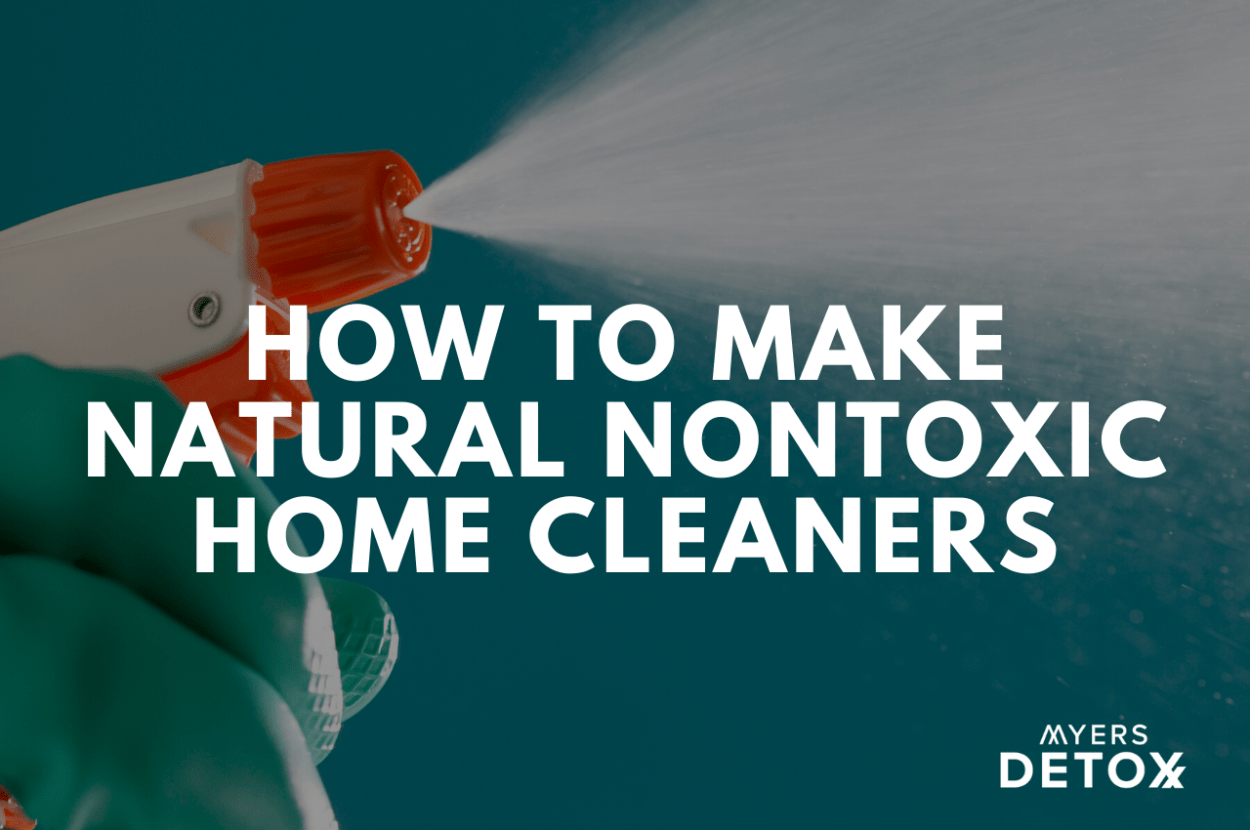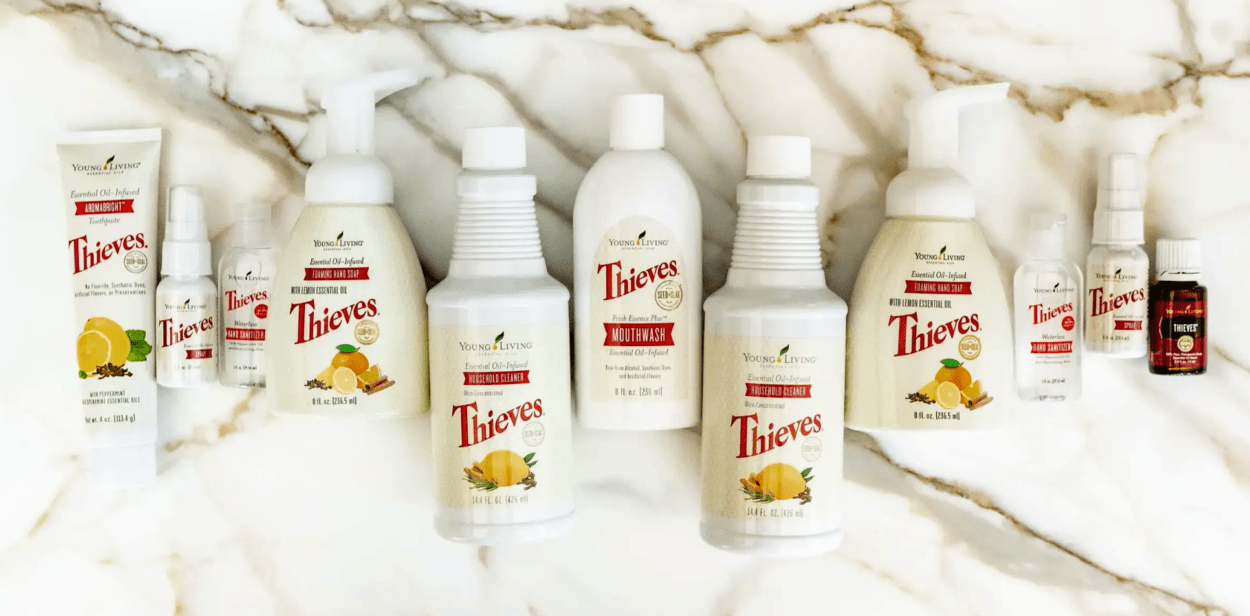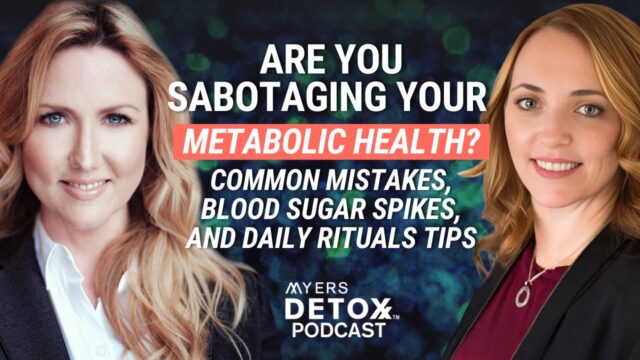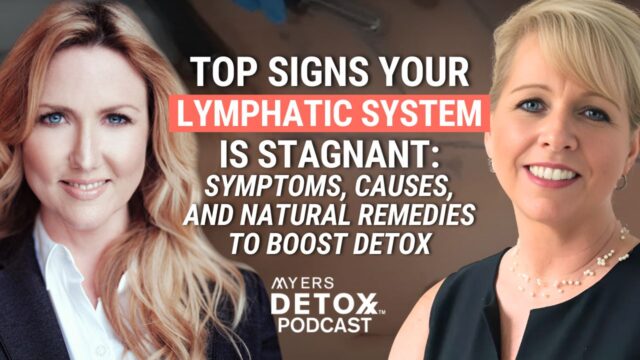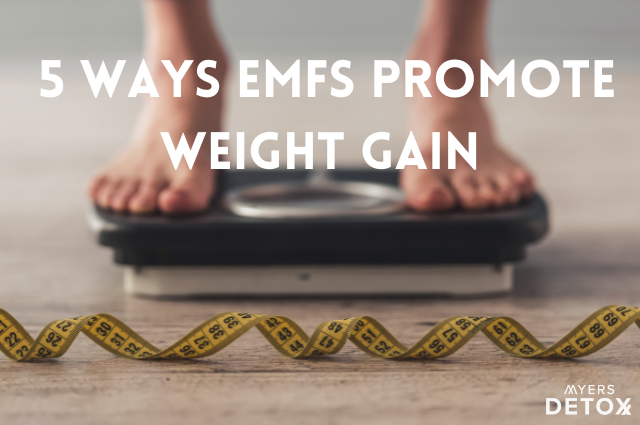Learn how to make your own natural, nontoxic home cleaners!
Ask yourself this:
When you clean your house, are you actually leaving your house “clean?” What I mean is, what types of chemicals are you allowing onto the surfaces you eat on, and the air that you breathe? And what is the collateral effect of this? What is this doing to your body?
Most people don’t ponder these questions. But they are critical questions to ask yourself.
I’ve always been flabbergasted by people that are obsessed with germs and killing them at all costs without thinking about the fact that the chemicals used in many household cleaners, bleach, and disinfectants are not easily handled by the body. Because the body isn’t used to these chemicals – consider that our bodies have only been exposed to them over the last few decades vs millions of year of human evolution – it’s not well equipped to excrete them.
The body is well-equipped to handle germs and bacteria. The immune system knows how to deal with pathogens. It has always seemed a bit comical to me the predicament germaphobes place on themselves. They should be obsessed with chemicals, not bacteria. There are natural alternatives to chemicals in cleaning supplies that in many cases work far better.
Many household cleaning products are loaded with toxins that can find their way into your body and wreak havoc. Research shows that these chemicals can cause a range of issues, including[1][2][3][11][12][13]:
- Neurological damage
- Hormone dysfunction
- Asthma and other respiratory issues
- Infertility and Birth defects
- Allergies and sensitivities
- Central nervous system dysfunction
And even many so-called natural cleaning products sold on the market are “greenwashed.”
Sold to the unsuspecting consumer, they’re not really natural or nontoxic and still contain chemicals sneaking in under one or more ingredients. The most common offence being a perfectly good nontoxic product but that still has “fragrance” on the ingredient list – which can contain 100’s of chemicals itself.
Or a brand with slick marketing labels these products as “clean” and “clear” or “fragrance free.” And they really just used more chemicals to cover up the smell of the chemicals in the product!
So what’s the solution? Like many other things in life – if you want something done right, do it yourself. That’s why I advise people to make their own household cleaners.
In this article, you’ll learn:
- Common toxins in your home cleaners
- Which natural cleaning ingredients to stock up on
- 7 DIY cleaning product recipes
- What to do if you don’t have time to “do it yourself”
Common Toxins In Cleaning Products
While there are hundreds of potentially harmful ingredients in common household cleaners, below are just a handful of chemicals to watch out for.
Phthalates
Phthalates are used in almost every household cleaning product because they’re used to help a fragrance stay in your carpet, in your clothes or on shower walls so they smell “fresh.” These compounds are endocrine-disrupting and pose a particular risk for the male reproductive system [1].
Triclosan
Triclosan is a common ingredient used for its antimicrobial activity. The primary issue associated with triclosan (and other antimicrobial ingredients) is the tendency for this compound to instigate antibiotic resistant bacteria. With antibiotic resistance, bacteria become resistant to drugs, posing a massive issue for human health[4].
Triclosan also has decimated the health of many lakes and rivers. It’s environmentally irresponsible to buy products with this ingredient.
Ammonia
Ammonia is a common ingredient in window cleaners and glass cleaners. This ingredient helps to give you a streak-free shine but is associated with serious respiratory issues like asthma[5].
Chlorine
As the primary ingredient in bleach, chlorine can be found hiding in a number of household cleaning products. One of the most significant health effects of chlorine is its impact on thyroid health as it can interfere with normal thyroid hormone production. [6]
Quaternary Ammonium Compounds
Quaternary Ammonium Compounds, also known as QUATS, are another disinfectant ingredient that may lead to antibiotic resistance. QUATS are often used in products like cleaning wipes, oven cleaners, and toilet bowl cleaners [7].
1,4-Dioxane
1,4-Dioxane is a compound that helps your cleaning products make suds, like soaps and detergents. It’s found in bleach. The EPA (environmental protection agency) considers 1,4-dioxane a probable carcinogen and is listed as an animal carcinogen by the National Toxicology Program.
Ethanolamine Compounds
Ethanolamine Compounds are used as emulsifiers in cleaning products. When these compounds are mixed with preservatives, they can form a secondary compound called nitrosamines, which are potentially carcinogenic. What’s more, research suggests that ethanolamine compounds may also lead to organ system toxicity. [8]
Natural Cleaning Ingredients To Stock Up On
There are a handful of natural ingredients that you can use for a wide range of cleaning needs. Life can be unpredictable, so I like to have the following on hand, so I know that I’m covered.
Cleaning ingredients:
- Castile soap (like Dr. Bronner’s Soap)
- Essential oils
- Borax
- Baking soda
- Vinegar
- Hydrogen peroxide
- Salt
How to Make Natural, Nontoxic Home Cleaners
All-Purpose Cleaner
All-purpose cleaner, as the name suggests, can help you with almost any mess. It works on a wide range of surfaces and is great for spot treatment on floors and countertops.
Ingredients:
- 1 tsp borax
- 1/2 tsp washing soda
- 1 tsp liquid castile soap
- Essential oils (lavender, tea tree, and lemon work great)
Instructions:
- Place borax, washing soda, and soap in a spray bottle, and add two cups of warm water.
- Pro tip: Distilled water is best.
- Next, add your essential oils. 15-20 drops of your oil of choice will provide a nice balance of scent without going overboard.
- Cover the bottle and shake it well so that all the ingredients are well incorporated.
- Use as needed. As mentioned before, this all-purpose cleaner can be used on pretty much any surface in your home. I like to keep a bottle in each bathroom too.
Dish Soap
Since dish soap is typically used with bare hands, this is one of the most crucial household cleaners that should be made with clean ingredients. You can make this recipe in bulk since dish soap tends to be an everyday cleaning product, and it will stay good for a while.
Ingredients:
- 2/3 cup castile soap or Dr Bronners Soap
- 1 1/3 cup distilled water
- 40 drops essential oil of choice (optional)
- 1 tablespoon washing soda
- 1 tablespoon salt
- 3 tablespoons hot water
Instructions:
- Begin by heating three tablespoons of water in a small pot and add in your salt, stirring until the salt is completely dissolved. Once dissolved, pour into a small bowl and set aside.
- In the same small pot, add the washing soda and your distilled water and put back on the stove to heat until the washing soda is dissolved.
- Next, grab your soap dispenser and add the castile soap or Dr Bronner’s, washing soda mixture, and essential oils together, mix to combine. Then add one tablespoon of the salt water to the soap mixture and stir. For a thicker soap, add more of the salt mixture.
- Use as needed to clean dishes, cookware, silverware, etc.
Oven Cleaner
Getting your oven sparkling clean typically calls for all the reinforcements — not to mention some serious elbow grease. This is one of the primary areas of your kitchen that you cook food in. You want to make sure that when you turn your oven on there aren’t any harmful chemicals getting into your food and evaporating into your kitchen that you breathe in.
Try this simple recipe for a “clean” oven.
Ingredients:
- 1/4 cup liquid dish soap (see recipe above)
- 1/2 cup baking soda
- 1/4 cup hydrogen peroxide
- Zest of one lemon
- 1 tablespoon vinegar
Instructions:
- In a small container or bowl, mix together all the ingredients until it becomes thick and glue-like.
- Remove the oven racks, and use a sponge to cover the inside surfaces of the oven with your cleaner.
- Allow the cleaner to sit in the oven for about four hours so it can fully work on all the grime.
- After several hours, use a damp sponge to remove the cleaner. For tougher areas, you may want to scrub just a bit.
- Run the self-cleaning mode on your oven and then allow it to cool.
- You may want to use a sponge to do one last wipe down.
Laundry Detergent
Most people don’t realize that you can make your own laundry detergent. Household products like spray and dish soap are popular DIY recipes, but laundry detergent doesn’t get the attention it deserves.
With that being said, the products you clean your clothes with literally end up all over your body, so using a DIY recipe can be the safest way to go.
Ingredients:
- 4 cups borax
- 4 cups washing soda
- 2 cups baking soda
- 2-4 castile bar soap, grated or powdered
- 10-20 drops essential oil (optional)
Instructions:
- Your first step is to chop up the soap bars into large chunks, and then either grate or put them in a food processor until you get a fine powder. Or you can buy castile soap already in a powder form.
- In a separate bucket or plastic tub, mix together the borax, washing soda, and baking soda (you may want to wear gloves for this part as these ingredients can be mildly irritating to the skin).
- Add in the castile soap bar powder and mix well.
- If desired, add in 10 to 20 drops of essential oil of choice (keep in mind that your clothes will smell like the essential oil you add, so make sure it’s one that you really like!)
- Store your detergent in an airtight container, and use one to two tablespoons per load (this recipe makes about 200 loads worth, so you should be good for a while.)
Toilet Bowl Cleaner
Your toilet bowl is not as dirty as your kitchen sink, believe it or not. But you definitely want some serious antibacterial punch with your natural DIY toilet cleaner.
This recipe is simple yet effective, and of course,100% natural.
Ingredients:
- 1 cup water distilled or boiled water for long-term use
- 1/2 cup baking soda
- 1/2 cup castile soap
- 15-30 drops essential oil of choice
- Hydrogen peroxide (optional)
Instructions:
- Add the liquid ingredients (water and castile soap) together into a squirt bottle. You may want to use a small funnel depending on the size of the opening.
- Add the baking soda to your mixture.
- If you want to add essential oils, you can add 15-30 drops of the essential oil of your choice.
- Shake well to mix.
- For extra disinfectant power, you can also spray the toilet bowl with a mixture of one part hydrogen peroxide and one part water (in a separate container then the bowl cleaner mixture).
- Be sure to shake your toilet cleaner mix before each use as the ingredients may naturally separate.
Window and Glass Cleaner
There’s nothing quite as satisfying as cleaning a dirty mirror or window to perfection. And of course, those streak-free glass cleaners make the experience even more enjoyable as you get that crystal clear finish. The problem is, many glass cleaners use toxic compounds like ammonia to create that streak-free shine.
In place of your standard glass cleaner, try using this DIY recipe for a much safer streak-free shine. Vinegar for the win!!
Ingredients:
- 2 cups of water (I use filtered or distilled)
- 2 tablespoons vinegar
- 10 drops essential oil of choice (lemon, orange, or any other citrus scent works great)
Instructions:
- Mix the water, vinegar, and essential oils in a glass spray bottle and shake well to combine.
- Use as needed on any glass surface.
Tile Cleaner
Tiles can be one of the most difficult surfaces to clean. This is especially true for the grout set in between the tiles. But of course, there is a natural solution to those grimey tiles. Next time you’re going for a deep clean in the bathroom or kitchen, try this DIY recipe.
Ingredients:
- 1/2 cup baking soda
- 2 tablespoons of washing soda
- 2 tablespoons of borax
- 3 tablespoons of liquid castile soap or Dr Bronner’s
Instructions:
- Mix the baking soda and washing soda together, then add in the borax. Next, add in the liquid castile soap and stir all the ingredients together.
- Before using your DIY mix, pre-wipe the surface with vinegar, and follow by scrubbing with the baking soda mixture. You can use a sponge or any type of scrubber. For tougher stains, let the mixture sit for up to 15 minutes before scrubbing.
- This is a DIY recipe you’ll want to make on the spot, as opposed to making it to store and use later. Luckily it only takes about three minutes to whip up.
- Note: if you notice mold in your grout, try some hydrogen peroxide (1 part hydrogen peroxide mixed with 1 part water). That will bleach it out and is MUCH safer than bleach.
Don’t Have Time To DIY?
Okay, I get it, we don’t all have time to make our own house cleaning products. Most of us don’t even have enough time to make our own meals.
So here’s the deal, if you want to keep your home clean but don’t have the time or energy to make your products from scratch, there is another option I love: the Young Living Thieves Starter Bundle.
This kit comes with everything you need for natural antimicrobial household cleaning products, and the ingredients are just as good as they would be if you made the products yourself. They are scented with Thieves Essential oil, which smells heavenly!
Thieves is a blend of clove, lemon, cinnamon, eucalyptus, and rosemary essential oils that fills any space with a rich, spicy aroma. It is one of my favorite essential oils.
If I’m entirely honest, as a busy woman myself, I go with the products in this kit more than half the time as opposed to making my own. I do make my own cleaners, but I have this as a backup if I’m pressed for time.
The starter bundle comes complete with:
- 1 bottle (15mL) Thieves essential oil (an excellent cleaner that you can use to make DIY home cleaning products)
- 2 Thieves household cleaners (concentrated cleaner that you can use for virtually any home cleaning need)
- 2 Thieves waterless hand sanitizers
- 2 bottles of Thieves spray (perfect cleaner for on-the-go)
- 2 Thieves foaming hand soaps
- Thieves AromaBright toothpaste
- Thieves mouthwash
As you can see, Young Living really covered all the bases in this kit. So if you’re all-in for clean household products, but don’t know if you want to commit to the DIY method — grab a Thieves starter bundle.
Takeaway
As a result of toxic chemical use in the home, it’s not surprising that the U.S. Environmental Protection Agency (EPA) found the levels of air pollution inside the home can be two to five times higher (and sometimes even 100 times higher) than outdoor levels. [9]
If that doesn’t get your attention, a study comparing women who work outside the home with women who work at home, found a 54% higher risk of developing cancer in women who work at home. The study concluded that this is a direct result of the chemicals in household products. [10]
The cleaning products that you use every day could be a significant source of toxicity in your home. The solution? Go for cleaner cleaning.
It’s much cheaper to make your own cleaning products, so expense is not a factor in switching to healthier cleaners.
Replace your toxic products. It’s time to up your cleaning game in your home and opt for better for yourself and your family. Whether this means opting for the DIY methods or going with a super clean product like Thieves Household cleaner, you should feel as good about the products you use to clean your home as you do about the food you consume and personal care products you put on your body.


